Rodolphe Jenatton
CMAP
Pi-DUAL: Using Privileged Information to Distinguish Clean from Noisy Labels
Oct 10, 2023Abstract:Label noise is a pervasive problem in deep learning that often compromises the generalization performance of trained models. Recently, leveraging privileged information (PI) -- information available only during training but not at test time -- has emerged as an effective approach to mitigate this issue. Yet, existing PI-based methods have failed to consistently outperform their no-PI counterparts in terms of preventing overfitting to label noise. To address this deficiency, we introduce Pi-DUAL, an architecture designed to harness PI to distinguish clean from wrong labels. Pi-DUAL decomposes the output logits into a prediction term, based on conventional input features, and a noise-fitting term influenced solely by PI. A gating mechanism steered by PI adaptively shifts focus between these terms, allowing the model to implicitly separate the learning paths of clean and wrong labels. Empirically, Pi-DUAL achieves significant performance improvements on key PI benchmarks (e.g., +6.8% on ImageNet-PI), establishing a new state-of-the-art test set accuracy. Additionally, Pi-DUAL is a potent method for identifying noisy samples post-training, outperforming other strong methods at this task. Overall, Pi-DUAL is a simple, scalable and practical approach for mitigating the effects of label noise in a variety of real-world scenarios with PI.
Three Towers: Flexible Contrastive Learning with Pretrained Image Models
May 29, 2023



Abstract:We introduce Three Towers (3T), a flexible method to improve the contrastive learning of vision-language models by incorporating pretrained image classifiers. While contrastive models are usually trained from scratch, LiT (Zhai et al., 2022) has recently shown performance gains from using pretrained classifier embeddings. However, LiT directly replaces the image tower with the frozen embeddings, excluding any potential benefits of contrastively training the image tower. With 3T, we propose a more flexible strategy that allows the image tower to benefit from both pretrained embeddings and contrastive training. To achieve this, we introduce a third tower that contains the frozen pretrained embeddings, and we encourage alignment between this third tower and the main image-text towers. Empirically, 3T consistently improves over LiT and the CLIP-style from-scratch baseline for retrieval tasks. For classification, 3T reliably improves over the from-scratch baseline, and while it underperforms relative to LiT for JFT-pretrained models, it outperforms LiT for ImageNet-21k and Places365 pretraining.
When does Privileged Information Explain Away Label Noise?
Mar 03, 2023
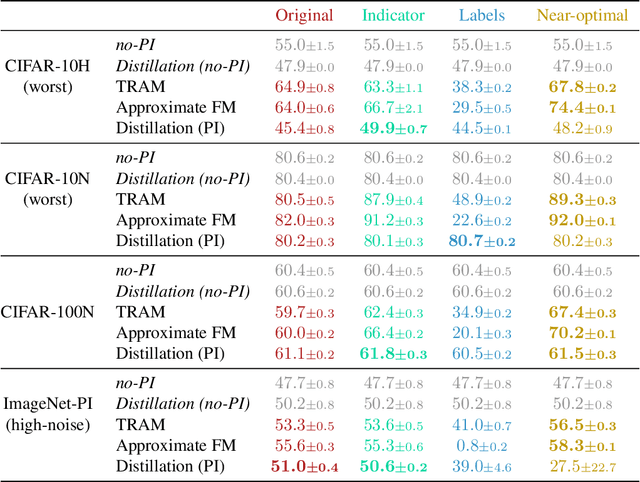
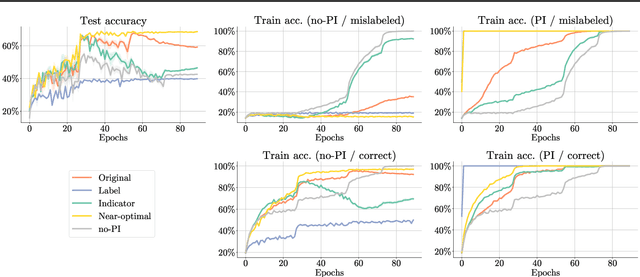

Abstract:Leveraging privileged information (PI), or features available during training but not at test time, has recently been shown to be an effective method for addressing label noise. However, the reasons for its effectiveness are not well understood. In this study, we investigate the role played by different properties of the PI in explaining away label noise. Through experiments on multiple datasets with real PI (CIFAR-N/H) and a new large-scale benchmark ImageNet-PI, we find that PI is most helpful when it allows networks to easily distinguish clean from noisy data, while enabling a learning shortcut to memorize the noisy examples. Interestingly, when PI becomes too predictive of the target label, PI methods often perform worse than their no-PI baselines. Based on these findings, we propose several enhancements to the state-of-the-art PI methods and demonstrate the potential of PI as a means of tackling label noise. Finally, we show how we can easily combine the resulting PI approaches with existing no-PI techniques designed to deal with label noise.
Scaling Vision Transformers to 22 Billion Parameters
Feb 10, 2023



Abstract:The scaling of Transformers has driven breakthrough capabilities for language models. At present, the largest large language models (LLMs) contain upwards of 100B parameters. Vision Transformers (ViT) have introduced the same architecture to image and video modelling, but these have not yet been successfully scaled to nearly the same degree; the largest dense ViT contains 4B parameters (Chen et al., 2022). We present a recipe for highly efficient and stable training of a 22B-parameter ViT (ViT-22B) and perform a wide variety of experiments on the resulting model. When evaluated on downstream tasks (often with a lightweight linear model on frozen features), ViT-22B demonstrates increasing performance with scale. We further observe other interesting benefits of scale, including an improved tradeoff between fairness and performance, state-of-the-art alignment to human visual perception in terms of shape/texture bias, and improved robustness. ViT-22B demonstrates the potential for "LLM-like" scaling in vision, and provides key steps towards getting there.
Massively Scaling Heteroscedastic Classifiers
Jan 30, 2023



Abstract:Heteroscedastic classifiers, which learn a multivariate Gaussian distribution over prediction logits, have been shown to perform well on image classification problems with hundreds to thousands of classes. However, compared to standard classifiers, they introduce extra parameters that scale linearly with the number of classes. This makes them infeasible to apply to larger-scale problems. In addition heteroscedastic classifiers introduce a critical temperature hyperparameter which must be tuned. We propose HET-XL, a heteroscedastic classifier whose parameter count when compared to a standard classifier scales independently of the number of classes. In our large-scale settings, we show that we can remove the need to tune the temperature hyperparameter, by directly learning it on the training data. On large image classification datasets with up to 4B images and 30k classes our method requires 14X fewer additional parameters, does not require tuning the temperature on a held-out set and performs consistently better than the baseline heteroscedastic classifier. HET-XL improves ImageNet 0-shot classification in a multimodal contrastive learning setup which can be viewed as a 3.5 billion class classification problem.
On the Adversarial Robustness of Mixture of Experts
Oct 19, 2022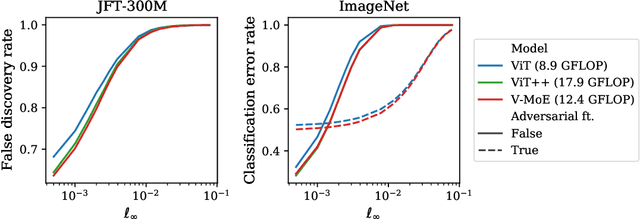
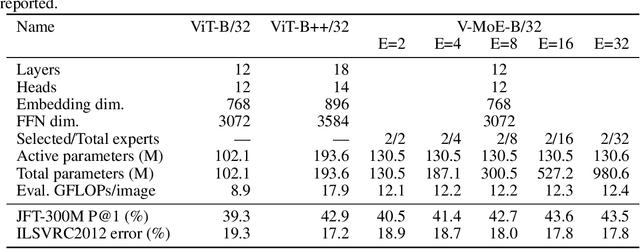


Abstract:Adversarial robustness is a key desirable property of neural networks. It has been empirically shown to be affected by their sizes, with larger networks being typically more robust. Recently, Bubeck and Sellke proved a lower bound on the Lipschitz constant of functions that fit the training data in terms of their number of parameters. This raises an interesting open question, do -- and can -- functions with more parameters, but not necessarily more computational cost, have better robustness? We study this question for sparse Mixture of Expert models (MoEs), that make it possible to scale up the model size for a roughly constant computational cost. We theoretically show that under certain conditions on the routing and the structure of the data, MoEs can have significantly smaller Lipschitz constants than their dense counterparts. The robustness of MoEs can suffer when the highest weighted experts for an input implement sufficiently different functions. We next empirically evaluate the robustness of MoEs on ImageNet using adversarial attacks and show they are indeed more robust than dense models with the same computational cost. We make key observations showing the robustness of MoEs to the choice of experts, highlighting the redundancy of experts in models trained in practice.
Plex: Towards Reliability using Pretrained Large Model Extensions
Jul 15, 2022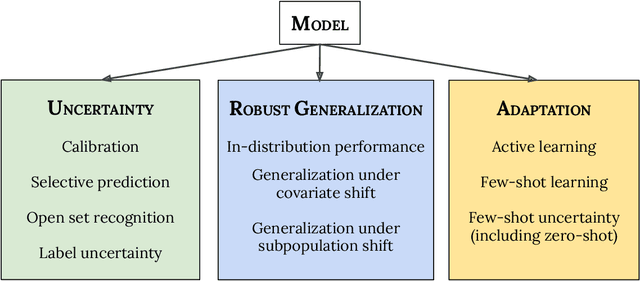

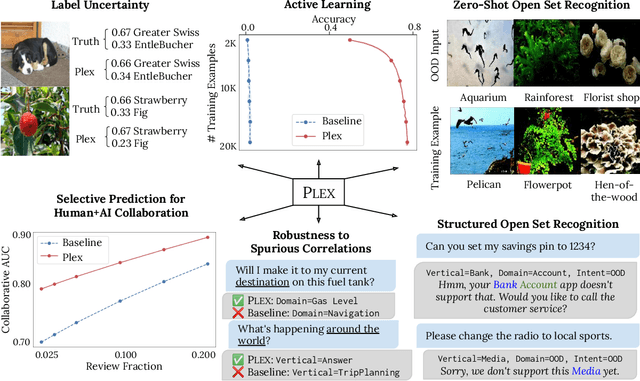

Abstract:A recent trend in artificial intelligence is the use of pretrained models for language and vision tasks, which have achieved extraordinary performance but also puzzling failures. Probing these models' abilities in diverse ways is therefore critical to the field. In this paper, we explore the reliability of models, where we define a reliable model as one that not only achieves strong predictive performance but also performs well consistently over many decision-making tasks involving uncertainty (e.g., selective prediction, open set recognition), robust generalization (e.g., accuracy and proper scoring rules such as log-likelihood on in- and out-of-distribution datasets), and adaptation (e.g., active learning, few-shot uncertainty). We devise 10 types of tasks over 40 datasets in order to evaluate different aspects of reliability on both vision and language domains. To improve reliability, we developed ViT-Plex and T5-Plex, pretrained large model extensions for vision and language modalities, respectively. Plex greatly improves the state-of-the-art across reliability tasks, and simplifies the traditional protocol as it improves the out-of-the-box performance and does not require designing scores or tuning the model for each task. We demonstrate scaling effects over model sizes up to 1B parameters and pretraining dataset sizes up to 4B examples. We also demonstrate Plex's capabilities on challenging tasks including zero-shot open set recognition, active learning, and uncertainty in conversational language understanding.
Multimodal Contrastive Learning with LIMoE: the Language-Image Mixture of Experts
Jun 06, 2022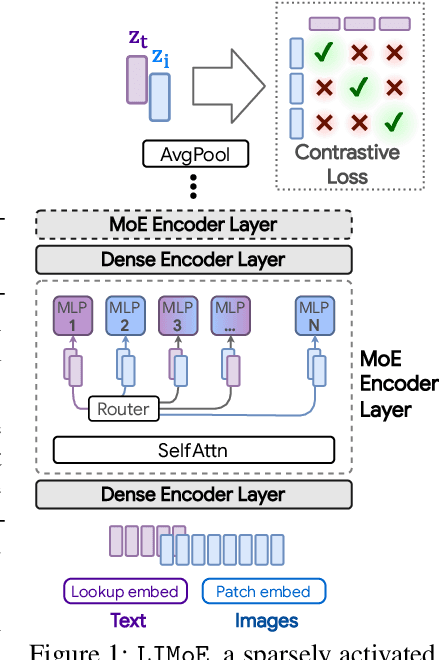

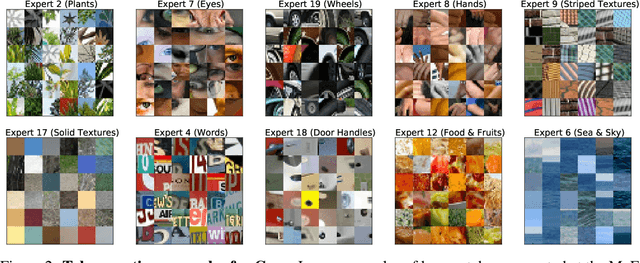

Abstract:Large sparsely-activated models have obtained excellent performance in multiple domains. However, such models are typically trained on a single modality at a time. We present the Language-Image MoE, LIMoE, a sparse mixture of experts model capable of multimodal learning. LIMoE accepts both images and text simultaneously, while being trained using a contrastive loss. MoEs are a natural fit for a multimodal backbone, since expert layers can learn an appropriate partitioning of modalities. However, new challenges arise; in particular, training stability and balanced expert utilization, for which we propose an entropy-based regularization scheme. Across multiple scales, we demonstrate remarkable performance improvement over dense models of equivalent computational cost. LIMoE-L/16 trained comparably to CLIP-L/14 achieves 78.6% zero-shot ImageNet accuracy (vs. 76.2%), and when further scaled to H/14 (with additional data) it achieves 84.1%, comparable to state-of-the-art methods which use larger custom per-modality backbones and pre-training schemes. We analyse the quantitative and qualitative behavior of LIMoE, and demonstrate phenomena such as differing treatment of the modalities and the organic emergence of modality-specific experts.
Transfer and Marginalize: Explaining Away Label Noise with Privileged Information
Feb 18, 2022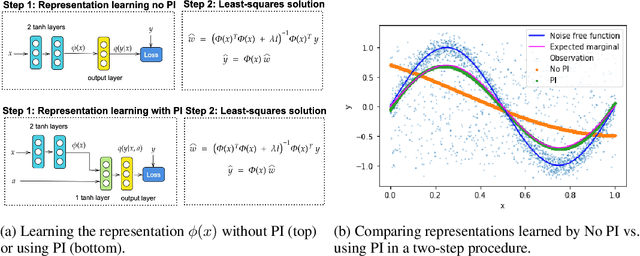
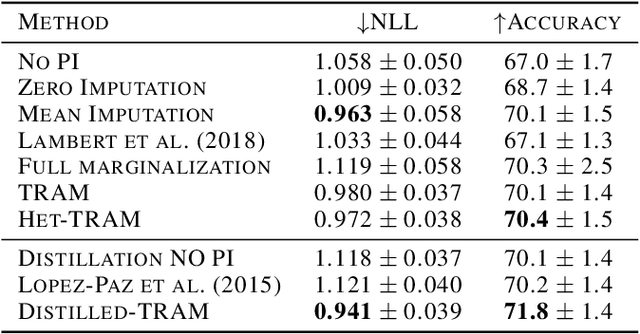
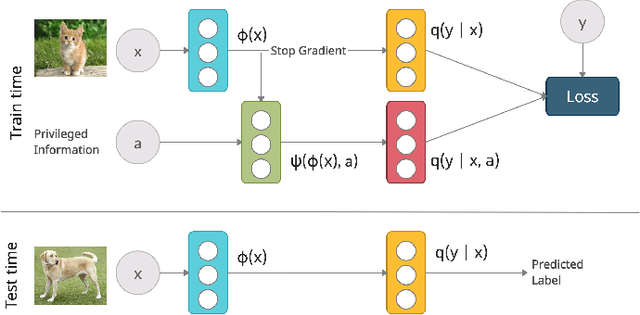
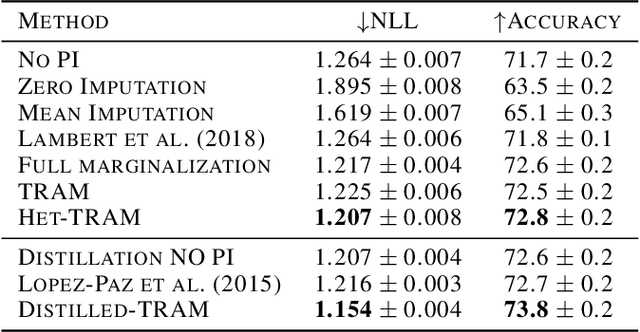
Abstract:Supervised learning datasets often have privileged information, in the form of features which are available at training time but are not available at test time e.g. the ID of the annotator that provided the label. We argue that privileged information is useful for explaining away label noise, thereby reducing the harmful impact of noisy labels. We develop a simple and efficient method for supervised neural networks: it transfers via weight sharing the knowledge learned with privileged information and approximately marginalizes over privileged information at test time. Our method, TRAM (TRansfer and Marginalize), has minimal training time overhead and has the same test time cost as not using privileged information. TRAM performs strongly on CIFAR-10H, ImageNet and Civil Comments benchmarks.
Predicting the utility of search spaces for black-box optimization: a simple, budget-aware approach
Dec 16, 2021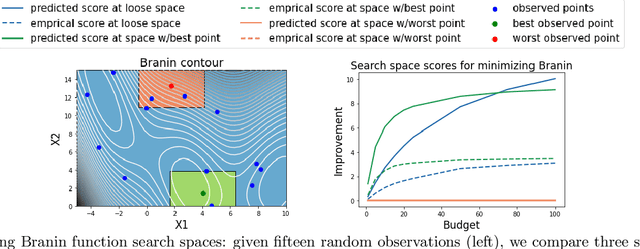
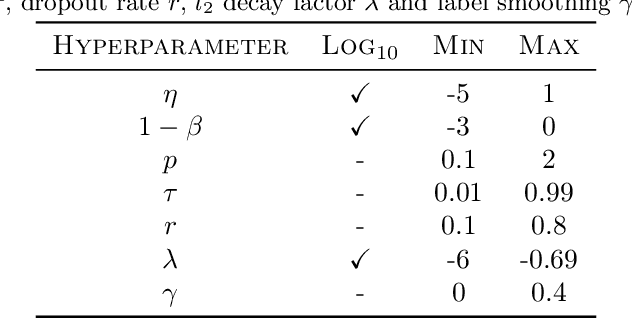
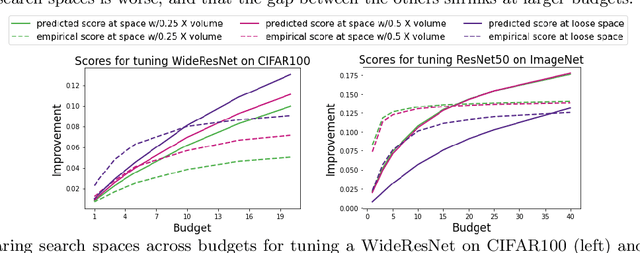
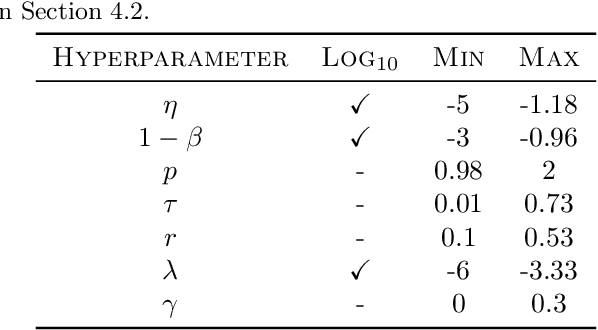
Abstract:Black box optimization requires specifying a search space to explore for solutions, e.g. a d-dimensional compact space, and this choice is critical for getting the best results at a reasonable budget. Unfortunately, determining a high quality search space can be challenging in many applications. For example, when tuning hyperparameters for machine learning pipelines on a new problem given a limited budget, one must strike a balance between excluding potentially promising regions and keeping the search space small enough to be tractable. The goal of this work is to motivate -- through example applications in tuning deep neural networks -- the problem of predicting the quality of search spaces conditioned on budgets, as well as to provide a simple scoring method based on a utility function applied to a probabilistic response surface model, similar to Bayesian optimization. We show that the method we present can compute meaningful budget-conditional scores in a variety of situations. We also provide experimental evidence that accurate scores can be useful in constructing and pruning search spaces. Ultimately, we believe scoring search spaces should become standard practice in the experimental workflow for deep learning.
 Add to Chrome
Add to Chrome Add to Firefox
Add to Firefox Add to Edge
Add to Edge